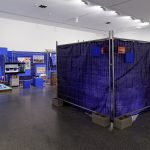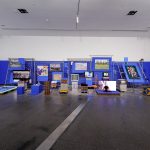
Who's Afraid of Public Space?
The Hoarding
Overview
The planning and design of the urban environment has been calibrated as an engine for economic growth with neighbourhoods being transformed into locational assets, and this quest for growth becomes a self-fulfilling cycle as each metropolis strives against each other to be top on the list of the world’s most liveable, smartest, innovative, competitive or confident cities in order to accumulate more capital. The construction hoarding acts as a device to demarcate this cycle of development: of demolition, renovation and adaptation coupled with the financialisation and privatisation of land and property. The hoarding also conceals this act.
Sibling introduces a hoarding at ACCA’s exhibition Who’s Afraid of Public Space? to frame the offsite work of the exhibition; the hoarding reveals through its concealment of what is beyond. The Hoarding is constructed of proprietary elements, including besser blocks, mesh fencing and tarpaulin, assembled as a temporary ‘tableau vivant’ before it takes life on another project of the city. The presentation of the hoarding in Chroma key blue provides a digital background on which you can project what you want. Which side of The Hoarding are you on?
This project was commissioned by the Australian Centre for Contemporary Art, Melbourne, 2021.



The construction hoarding acts as a device to demarcate this cycle of development: of demolition, renovation and adaptation coupled with the financialisation and privatisation of land and property.
The hoarding also conceals this act.





The construction hoarding acts as a device to demarcate this cycle of development: of demolition, renovation and adaptation coupled with the financialisation and privatisation of land and property.
The hoarding also conceals this act.






